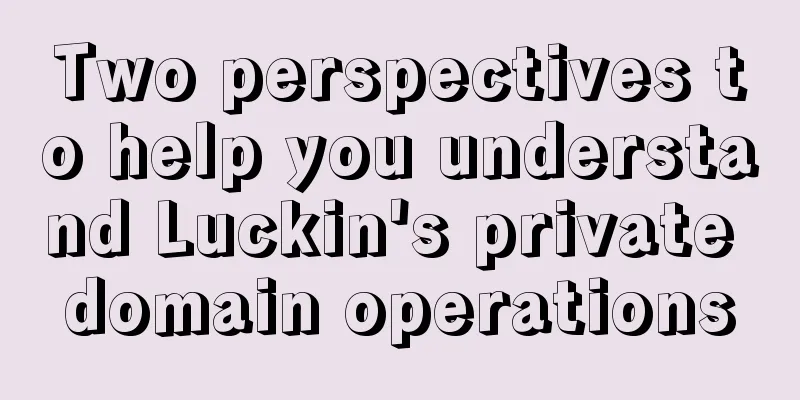Playing with the "Super User Plan" 5 ▎Why are so many people keen on the plan? Explore the four major motivations to activate participation enthusiasm!

If you want the Super User Program to be truly successful, one of the first tasks is to attract, invite and motivate people with abilities and values to join. The key, then, is to drill down and understand: “What drives them to want to be part of the program?” Once you find the answer, you can formulate and adjust the corresponding incentives to ensure that these super users always maintain a high sense of engagement, value and pride, and are willing to speak up for you, stand up for you, create wonderful content, and actively participate in brand innovation. This article will help you better understand the user's motivation for participation by disassembling three cases of Lego, jumping into the sea and Keep, divided into four parts and 6,000 words:
1. What makes users willing to join the "Super User Program"?"Self-Determination Theory" believes that when the three basic needs are fully met, the "peak" of motivation will appear: ability, autonomy, and relatedness. Further analysis:
However, the challenge here is that users and members are often not clear about what their true motivations are. Even if they have some understanding of their motivations, they are reluctant to be honest about it - "I do this because it feels great to give back" is often more acceptable than "I participate in the program to improve my status." Therefore, understanding the various subtle psychological motivations is crucial to developing an attractive "super user plan". 2. Basic cognition: different groups of people have different motivations, and they change at any timeEach group in a community has unique motivations that evolve over time as members gain experience. Therefore, it is critical to understand and observe these changes. By surveying data, you can better understand member behavior and make educated inferences. For example, members of technical communities are often motivated by competition. They are eager to stand out in the industry, eager to master top product knowledge or write unparalleled code. Many people want to be seen as leaders in the industry while seeking new job opportunities or career development. Providing them with a platform to showcase their talents and skills is undoubtedly an attractive motivating factor. For others, joining a program is a great opportunity to learn about the importance of a product or service. For those who write technology or product blogs, getting insider information or being one step ahead of others can be very attractive. For others, joining a program is a great opportunity to learn more about the importance of a product or service. For those who write technical or product blogs, getting insider information or being one step ahead of industry trends is undoubtedly an attractive lure.
In the field of consumer goods, satisfying people's desire to share and be the center of attention is often the key to success. Imagine inviting them to visit the factory, become the first to experience, or even participate in the product development team. These seemingly simple "actions" can inspire their inner enthusiasm. Such a unique experience will not only prompt them to join us eagerly, but also make them proudly share it all in their circle of friends, becoming the brand's spokesperson and disseminator.
In China, the same perception applies. In the opening statements of various UP hosts on Bilibili, we often hear such "stories": "I was invited to visit Gigabyte's factory"; "I got an internal movie ticket today"; "I'll go and explore the way for everyone"; and "The brand gave me a surprise gift package!"... Once again, different groups of people have different motivations. By the way, the motivations of company employees to participate in the "plan" are also different. Some may be eager to improve their abilities, others are simply pursuing the expression of their creativity, and some are hoping to earn extra income. Therefore, it is crucial to understand their motivations. The above is just to illustrate that when designing incentive mechanisms, we must take into account the unique motivations of different groups of people and avoid formulating a unified incentive strategy that is one-size-fits-all. 3. Four core motivations: passion, recognition, belonging and gloryWhen we dissect the needs, we find that everyone has their own spark behind the various activities they engage in. Some people devote themselves to it out of pure passion; some people aspire to be seen as thought leaders, trendsetters or top experts; and some people enjoy helping others and hope to shape a better future through their contributions to others and brands. When we break down these needs, we can easily find that they all point to four motivations: 1. Love and shareIt must be admitted that there is a group of people who are willing to devote themselves to an activity simply because of their love for "things". Their motivations are extremely pure - to convey "passion", share joy and gain resonance! In the past, this kind of "passion" was just an individual's small interest, and it could only be a trivial, marginal and scattered interest. However, the rise of social media has changed everything: they can easily show their works to the world and satisfy their inner sense of accomplishment; they can quickly find "like ones" to share each other's joy and enjoy the fun of like-minded people; what is even more surprising is that these niche and segmented passions are now officially placed under the spotlight of commercial value: monetization! In the eyes of these enthusiasts, small interests have become life itself, rebuilding these people's daily and social ways. ▍▏Case: LEGO - achieving each other through "love and sharing". LEGO has cleverly continued to create a series of amazing "Super User Programs" based on the players' level of "passion". Level 1, Super Player: "LEGO Certified Professional" (LCP), play around the world together. LEGO's "LEGO Certified Professionals" (LCP) program allows super enthusiasts to directly participate in LEGO's product innovation, brand building and business system. By 2024, there will be 23 "LEGO Certified Professionals" in the world.
Level 2, super enthusiasts: LEGO ambassadors, adult LEGO players (AFOL), etc., work together to create the world! According to the "passion" of adult players, LEGO has segmented and developed different support plans or platforms:
Level 3, Active People: People who keep talking and actively participate in activities As active super users, they weave a close connection with LEGO through every consumption, sharing, interaction and donation. Let me explain in advance that the difference between "passion" here and the following three motivations is that because of "passion", they are willing to invest time in the brand and are eager to become partners. They are looking for long-term belonging rather than short-term sustenance. 2. Express your desire and gain recognitionAs we all know, hundreds of millions of people participate in content creation every day, and the influence of some people is comparable to that of authoritative media. The reason is that the digital age has awakened "self-awareness", and unlimited media has made it easy to realize "desire to express". In this era where "everyone can be the protagonist", public recognition is the biggest incentive for creators. Every like, every comment, and every share is an affirmation of their efforts, forming a quantifiable recognition mechanism: clicks, readings, collections, and even the growth of followers and fans can ultimately be converted into considerable profits. This is an “increasing” “flywheel effect”: the more you express → the more recognition → the more influence → the more willing you are to express! Therefore, the brand’s “Super User Plan” is precisely to discover those users who are eager to express themselves, satisfy their “desire to express themselves”, help them gain more recognition, and help them become dazzling “stars”. Here, I would like to give a thumbs up to people like Wu Liufang who are willing to express themselves, support themselves, and work hard to live a good life! 3. Community and identityIn fact, many people like to feel that they are part of a team or a strong community : interest circles, utopian communities, youth nursing homes, like-minded groups, companions, cloud companionship, slow social interaction, etc. are all manifestations of this kind of motivation. Many super users are passionate about being a part of a brand because they feel like they are part of the family or a part of the brand.
For example, members of the Yelp Elite Squad say that being a member of them is like joining a "secret society," "Now that I'm finally a gold elite, certain parties are held just for us. It makes me feel like a VIP celebrity in San Francisco." ▍▏Case: Tiaohai Tavern—a model of “community belonging”! In Beijing, the team of bartenders jumping into the sea is close to 400 people, and the demand far exceeds the supply. The competition for weekend spots is fierce, and it has become a competition of hand speed and enthusiasm. In Beijing, Tiaohai has nearly 400 bartenders. The number of people who want to serve wine exceeds the number of people needed for Tiaohai, so you need to be quick to grab a spot on the weekend. Through the unique role of a bartender , Tiaohai has successfully connected young people from different communities. DRY, one of Tiaohai's earliest customers, said: "(Tiaohai) is to find the most fun young people in the area to get together and let everyone find the most relaxed state. Once you get to know each other, it's like your own living room." Every part-time bartender can clearly state the reason why they come here:
This refreshing "part-time bartender" model essentially taps into the motivation of "belonging", thus becoming the real driving force behind the success of "jumping into the sea". 4. Brand glory and satisfactionSome members may want a strong connection to the brand and gain satisfaction from participating in community activities. As Erica Kuhl points out, the motivations of Salesforce MVP program members can be summarized into two main aspects:
▍▏Case: Keep went public, and every medal played an important role! Since its official launch in 2015, Keep has experienced a decade of ups and downs. It was not until the All In medal gameplay in 2021 that it revitalized the internal circulation and successfully built an ecological closed loop. By 2023, the medal business will not only become the core driving force for the growth of membership subscriptions and online paid content, contributing more than 46% of revenue, but also help the company successfully list in Hong Kong. For example, in June 2023, the joint event between Keep and "Genshin Impact" attracted nearly 1.3 million users to participate, creating the highest user scale, of which more than 70% of the participants were new users. The gameplay of Keep Medal is simply: spend money + run. ① Notify the co-branded partner in advance ; ③ Make an appointment to participate; ② Pay the registration fee after going online; ④ Complete the goal within the specified time. (If you fail to complete it, you can apply for a refund during the event) ⑤ Share the success of the challenge. Where is the innovation? If every participant is regarded as a super user , then each co-branded medal is a unique "super user plan". There are endless activities on daily basis, such as city marathons, story competitions, and special festivals such as Valentine's Day and Chinese Valentine's Day; quarterly and annual activities such as year-end reports, medal memoirs, and medal transformation inject unique and exclusive memories into each medal. This all-round emotional mobilization not only enhances the stickiness between participants and Keep, but also makes the meaning of the medal transcend itself, becoming a carrier of emotions, a symbol of emotions, and a symbol of glory!
The success of Keep's medal model stems from the perfect combination of emotional value and social currency, and it can further explore the two motivations of "glory and satisfaction" .
The continuous expansion of the medal gameplay is a new "super user plan". In this process, the connection between users and brands becomes closer, forming a new "growth flywheel" . Love, recognition, belonging and glory, these four motivations do not exist in isolation, but complement each other and influence each other. Therefore, to formulate a reasonable "plan", it is necessary not only to accurately capture the core motivations of the target group, but also to cleverly expand to other related motivations , so that each motivation can release more powerful energy in the intersection! 4. How to understand the real motivations of super users?Imagine asking a super user “Are you here to improve your social status?” They would definitely say “no”. So how do you learn what your users are really motivated by? Don’t ask them directly — ask them other questions and see what you can extract from their responses. Let's see what kind of questions can quickly get us to the truth: 1. How did you hear about this program?Have they heard others talk about this program in any community, media, or website? If so, find out what makes the idea sound appealing. If they talk about specific rewards, that will help provide insight into motivations. 2. Why are you interested in this program?If the answer is "to give back," try to dig deeper. What do they do? Is there some connection to the program? 3. How would you like to get involved?These responses may give you some idea of the types of things they are interested in, which may indicate their motivations. For example, do they want to organize meetups (i.e. is networking one of the motivations?) 4. What suggestions do you have for the plan?If the answer has to do with publicity, then "status" is likely their motivation. 5. Why do you think you are a good fit for this program?Responses that list a skill set may indicate a need for exposure (they want others to know what they are good at) or education (they are interested in learning more/getting information or products.) 6. Tell us how you would describe [brand] to your colleagues/communityYou can glean information from the tone of the response. If they come off as overly bombastic or enthusiastic, exposure or association with the brand could be a trigger. For specific application forms and detailed questions, please refer to the next article "Recruitment" Finally, please note the following two points:
5. Summary of the review
[To be continued] |
<<: Why do young people on Xiaohongshu and Douyin flock to ski resorts?
>>: Cross-border e-commerce reaches a "new starting point"
Recommend
How long does it take to open a Lazada Super Alliance account? FAQ
As a cross-border e-commerce platform, Lazada'...
How to recover a stolen Shopee store? What to do if the account is frozen?
If the Shopee account is set up too simply, the st...
The work badge meme is going viral, and brands are going crazy!
The "work badge meme" has become popular...
Amazon joins hands with TikTok, has the world of cross-border e-commerce changed?
The cross-border e-commerce sector has ushered in ...
What exactly does the public-private domain joint growth model of Video Account mean?
As an important part of the WeChat ecosystem, Vide...
Introduction to the free traffic channel activity for slow-selling products on Pinduoduo’s homepage
Pinduoduo products have been in the homepage pool ...
Discount stores, how deep is the water?
What is the core problem of the discount store ind...
Is Amazon Prime Day free? Is it good for sellers?
Now many cross-border e-commerce platforms have me...
Xiaohongshu sells men's clothing, with sales of over 2 million
Xiaohongshu's men's clothing sales exceede...
What folk writings have you seen?
The copywriting comes from what we see and learn i...
How to set up cash on delivery in Lazada? How to activate it?
When we buy things on domestic e-commerce platform...
How to co-create content under social marketing?
Introduction: The advent of the Internet big data ...
Do Amazon sellers need to pay taxes on their earnings? How?
Amazon sellers do business with foreigners. Of cou...
Taobao and JD.com both cancel pre-sales during 618 promotion: the big promotion begins to enter a cooling-off period
Every year, pre-sale seems to be an indispensable ...
The secret of Meituan Waimai's successful World Cup marketing: 1 foundation, 3 highlights, and 1 necessary guarantee
The World Cup, held every four years, has come up ...









